The Projective Hypothesis of Personality Assessment
Discover how psychologists used general principles and conceptual similarities of projection to establish the sub-discipline of projective...
By tracing the history of the term projection you will better understand how we generate consumer insights backed by behavioral science.
The word “projection” is a rolling stone. It is one of the most commonly referenced psychological concepts by the general public. However, because of its proliferation across blogs, comics, and social media posts, recent updates on its meaning and use have been lost in translation.
While some comics, books, and films have used singular aspects of projection as a staple for successful content, those of us at Inkblot Analytics use a more holistic approach to the concept. This holistic approach to projection is what fuels our new projection-based technologies.
On a typical day at Inkblot Analytics, you’ll find us working on multiple technologies that incorporate different aspects of projection. To fully understand how these new projection-based technologies work, we think it’s crucial to understand the modern concept of projection.
By tracing the history of the term—from its origins, to how it’s conceptualized today—you will better understand how our process and technology leverages projection to generate consumer insights backed by behavioral science.
Scholars Hurry, Novick, and Novick (1976) note that projection is, “A pre-analytic term, the literal meaning being ‘to throw in front of’.” (p. 75) So it makes sense that projection’s general use within psychology came to mean the placement of an internal mental substance—a thought, feeling, or behavioral propensity—onto the external world.
For example, if it’s your first time at a formal event you might be worried about what other people are wearing and what attire is expected. If you think that all attendees must have the right kind of designer clothes, you might be the first to criticize someone else for being under-dressed. In this example, your basic understanding of event expectations are projected out into the world, and used to guide how you act. At its most fundamental level, this is the general concept of projection: taking internal thoughts/feelings and casting them out onto the social world. It is purely an externalization of internal perceptions.
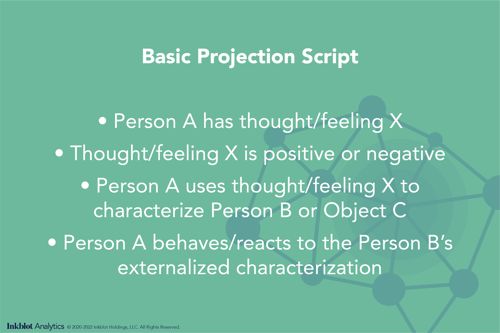
Throughout the years, psychologists have stayed very close to this metaphor of casting things out. For example, a number of written pieces on projection (Hurry et al., 1976 ) describe the process similar to the projection of film, where a tiny image on a film reel—the mind in this metaphor—is enlarged and presented on a screen external to the film reel and projector.
One of the most famous psychologists to elaborate on the concept of projection was Sigmund Freud.
The concept of psychological projection was popularized by Sigmund Freud, the founder of the school of psychoanalysis. It is important to note that Freud often wrote of projection in terms of both “normal” and pathological terms (Freud, 1894b,1895,1912).
Freud described “normal” projection similar to our discussion in the previous section. To him, generalized projection occurred when internal states influence perceptions of the outer world (Lindzey, 1961, p. 31). Therefore projection, in its simplest form, is more of a primitive mechanism by which the mind approaches the world. It’s only when these normal projections become maladaptive that they become pathological.
Freud penned his ideas of “pathological” projection within a larger body of work on defense mechanisms and their use according to his theory of the mind (Freud, 1894a/b, 1895, 1900, 1911, 1912, 1915, 1919, 1923).
Freud theorized that the structure of the human psyche materializes from a push and pull between instinctual pleasure drives (id), reality checks (ego), and morality (super ego). At times the impulses from our pleasure drives can create internal conflict with what’s happening in our life (via the ego) or feelings around what we should be doing (via the superego), producing anxiety. In order to protect ourselves against this anxiety, Freud believed that the mind unconsciously distorts reality through defense mechanisms (Freud, 1894a). In the case of Freudian projection, reality becomes distorted by casting internal worries onto external reality. Freud believed that if you could identify the projection, it could be a mirror into the individual’s psyche: reflecting the hidden battles between the id, ego, and superego.
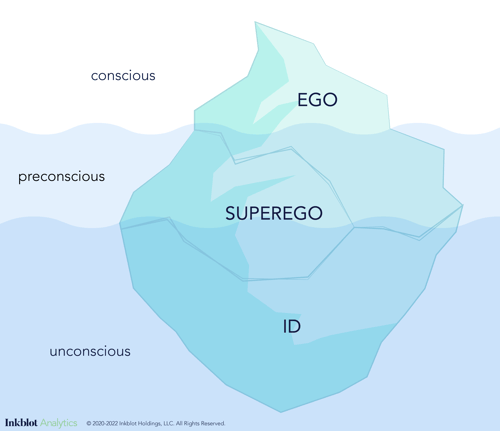
The conceptual distinction between “normal” or “generalized” projection and “pathological” projection was the introduction of anxiety. For Freud, if projection was used as a psychological defense against anxiety-provoking thoughts/feelings, then it could easily become maladaptive. This is why our “Freudian” script of projection introduces a line about anxiety in addition to the externalization process.
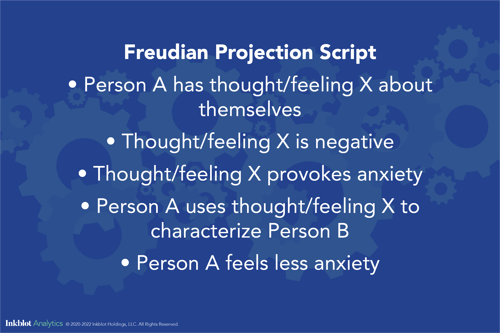
While Freud did write in detail about projection, the concept became more widely known through the work of his daughter.
In 1936 Sigmund Freud’s daughter, Anna, published The Ego and the mechanisms of defense, which established a taxonomy of defense mechanisms. Her work became a cornerstone in the field of psychoanalysis (Sayers, 1991). Anna extended her father’s classification by focusing on the developmental phases in which certain defense mechanisms become possible to use. For example, the act of projection can only work when the individual realizes a separation between their inner mental reality and external reality. So children who have yet to develop this differentiation are not yet ready to use projection.
Freud (1936) also highlighted the different combinations that defense mechanisms could take. For example, projection and identification were two defense mechanisms that could be combined into projective identification, which could manifest in everyday situations.
For example, imagine a situation where someone is doubting getting married to their partner but encourages their sister or best friend to get married. This example is part projection—the worries about getting married, projected onto a sister’s or friend’s relationship—and part identification—being able to feel good about helping a sister or friend get married as if they were helping themselves with their similar problem. Given these examples, projective identification at its most general level may look like what we call living vicariously through someone else.
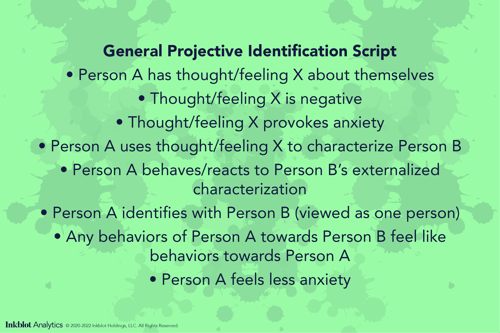
From a conceptual standpoint, the main difference between Sigmund Freud’s projection and Anna Freud’s projective identification is that in the former example, it’s the “casting out” of the negative aspects that helps. However for projective identification, it’s the casting out of the negative aspects plus acting out the solution (on the target of the projection) instead of the self.
Noticing the ways in which different defense mechanisms could work together became an interest to other scholars at the time as well; specifically Melanie Klein.
Melanie Klein, another psychoanalyst also from Austria, elaborated Freud’s term projective identification in 1946, and again in 1952. Klein focused on how projective identification could cause individuals to project traits or characteristics into someone they identify with, affecting the relationship between the two individuals.
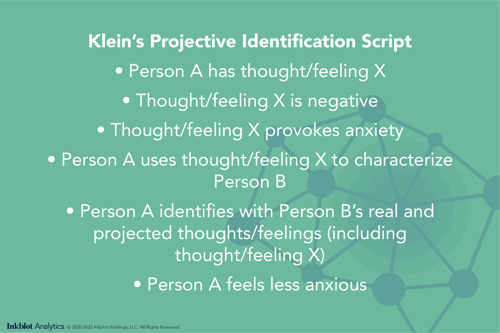
As a general example, suppose that a child has an unconscious feeling around not being good enough at sports. Instead of thinking “I’m not good at baseball,” the child would project that into another person, such as a parent. However, by also identifying with the parent, the child internalizes that they’re not good at baseball as if the thought originated from the parent.
Klein’s original concept theorizes that this process included both positive and negative aspects of the self, as she elaborated, “It is, however, not only the bad parts of the self which are expelled and projected, but also good parts of the self.” (Klein, 1946, p. 102)
The core differences between the general projective identification script and Klein’s projective identification script is a change in the type of identification. In the general projective identification example, Person A identifies with Person B in their entirety so that what happens to Person B feels like it’s also happening to Person A. In Klein’s example, the identification is not with the person as a whole, but specific thoughts/feelings that Person B has.
Other psychologists built upon Klein’s process of projective identification. These variations formulaically change the projective identification script (e.g., are you identifying with the person or the projection, as we learned in our last example).
Acquisitive projective identification (“I Am You”) was defined by British psychoanalytic writer Ronald Britton in his book Belief and Imagination (1998, p. 6). In this instance, instead of casting out those negative parts of the self, the individual tries to negate them by acquiring someone else's positive traits. In some instances, these positive traits are actually projected on to the person, and not “real.”
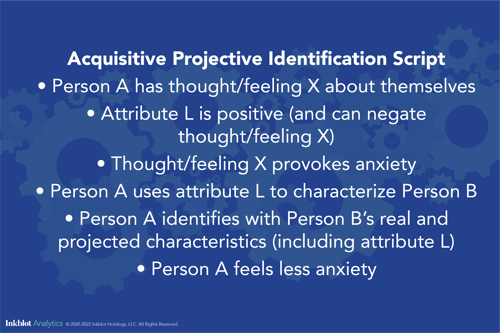
The big conceptual change in acquisitive projective identification is the valence of what is being projected. While typically negative aspects of the self are “cast out” onto others, in this example, positive idealized traits are projected onto others, for acquisition. On the other side of acquisitive projective identification, Britton described a form of attributive projection identification (“You Are Me”), where a person ascribes an internal anxious thought/feeling to another person (Britton, 1998, p. 6).
Projective counter-identification was proposed by Argentinian psychoanalyst León Grinberg within the context of therapy. In this instance, instead of the projector merely casting out negative parts of the self onto someone else (e.g. an analyst), the receiver passively and covertly acts out or feels the projection. This is not because the person truly feels that way, rather they are acting under the influence of the projection.
As a general example, suppose that a child has an unconscious feeling around not being good enough at sports. Instead of thinking “I’m not good at baseball,” the child would project that into another person (e.g. a parent). The child might try to avoid asking the parent for advice to improve in baseball. When the parent senses them distancing, they may perceive this as the child struggling, and might try to help by suggesting a few pointers.
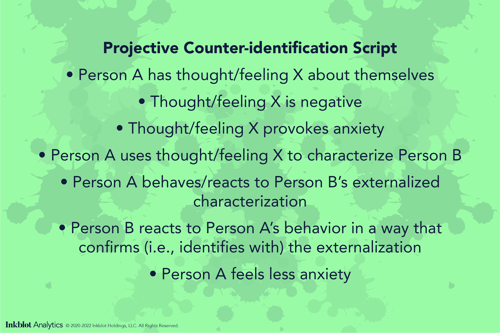
By suggesting a few pointers, the parent has confirmed (or, “identified with”) the original anxiety of the projection—the child is not good at baseball. And therein lies the trickiness of projective counter-identification. The projection causes the child to act in a way that forces the parent to identify with the root of the projection. This identification is not a genuine thought or feeling of their own, but seems like it to the child.
Dual projective identification was coined by therapist Joan Lachkar as a process when, “Both partners are simultaneously projecting into one another. Both deny the projections, and both identify with those projections.” (Lachkar, 1992, p. 92) With this concept we can think of a classic couples counseling scenario where both partners don’t get along because they think the other partner started it. Lackar provides the following example, where one person projects guilt, and the other projects shame: "You should be ashamed of yourself for being so needy! When you're so needy, I feel guilty!" In reality, no one started anything, they are feeding off each other’s energy.
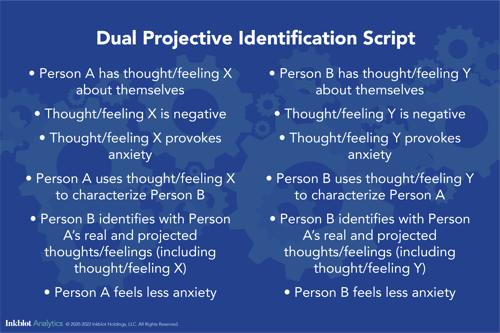
Klein and her followers weren’t the only psychoanalytic school of thought that extended the concept of projection. Jung, a colleague of Freud's, also developed the concept according to his theory of mind.
Swiss Psychiatrist Carl Jung gave new meaning to the word projection. In a lucid stream of premises from part II of his writings in General Aspects of Dream Psychology, Jung began with the proposition that the person is an “imago, or a carrier of imagos or symbols,” (Jung, 2012, p. 50). This is a reference to Jung’s collective unconscious, the place where we store archetypes and symbols from generations of human existence. Some of the archetypes and symbols are constantly “projected into our surroundings,”(Jung, 2012, p. 50).
When it came to the concept of projection, Jung's theoretical departure from Freud was in the conditions for projection. For Jung, projection required necessary conditions for it to work. Not just any projection could be projected on any one person. Instead, Jung explained that “the object offers a hook to the projection, and even lures it out,” (Jung 2012, p. 55). This “hook” might be a personality trait. Maybe they look similar to someone. Or maybe they act in a way that embodies the projection. This is the beginning of the interpersonal components of projection as a concept.
But not all of these “hooks” have to be real. In fact, they might not be real traits at all, they can be projections themselves. Jung continues, “For all projections provoke counter-projections when the object is unconscious of the quality projected by the subject.” (Jung, 2012, p. 55) The idea of counter-projection—which Jung parallels to the complementary processes of therapeutic transference and countertransference—reveals that we are susceptible to projecting onto someone who might be unconsciously reinforcing it. Unlike dual projective identification, counter projection relies on one person unconsciously enabling the projector, instead of both parties projecting and introjecting one another’s fantasies.
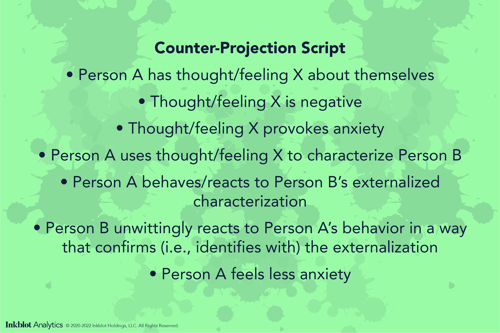
For example, this concept can explain the trope of two very close friends who become hot and cold because one person thinks the other likes them as more than a friend. Certain friendly behaviors (e.g., long eye contact, a big smile, or a soft touch) can act as a “hook” to misattribute that a friend has romantic feelings. It is usually upon realizing this projection, that one friend goes cold and avoids the other friend, so as to not ruin the friendship. As we know, projection involves casting out how we feel, or flipping the script. In this case one friend paints the picture that the other is expressing romantic signals, even though they’re the one with the desire for a romantic relationship.
The key difference is the mismatch, while person A does like their friend and is projecting this thought by “looking into” person B’s physical signals, person B is just acting like a normal friend, but is unaware that their friendly signals are feeding the projective source (i.e., person A’s thought about liking person B).Once person B becomes aware that their friendly behaviors (e.g., long eye contact, a big smile, or a soft touch) are causing person A to think they are more than friends, they disengage and become colder to prevent any further misread signals.
Overtime psychoanalysis and its concepts grew less popular in mainstream U.S. psychology, so emphasis on projection decreased. But recently, more psychoanalytic concepts have been reintroduced through different schools of thought. Projection—our proverbial wanderer—would take such a turn outside of the field of psychology, and into the hands of economists, where it gathered new forms that forever changed its complexion.
The term projection bias was first introduced in 2003 by economists Loewenstein, O’Donoghue, & Rabin to describe a person’s general tendency to project current preferences onto future ones. When making estimations about future preferences, or self-forecasting, people tend to ignore or undervalue factors like mood fluctuations, personality, habit formation, and adaptation to changes in the environment. This can cause people to make short-sighted, or sub-optimal, decisions concerning long-term health and overall well-being.
Projection Bias is a systematic misestimation of personal changes in future preferences (Loewenstein et. al., 2003).
A simple way to conceptualize the economist’s idea of projection is through the saying, don’t let your eyes write checks that your stomach can’t cash. We’ve all been there before—starving at a restaurant—so we happily order a large amount of food, believing that we can eat it all. But a few bites in, we realize that we’ve overestimated our appetite. Even worse, now we’re sad because we’ve created food waste and overspent.
This form of bias exists because consumers fundamentally assume that the way they feel now is the way that they are going to feel in the future.
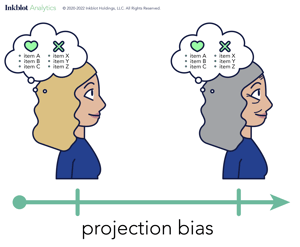
The term social projection was coined in 1924 by American psychologist Floyd Henry Allport. It is a process for understanding the social world that involves the expectation that others will have similarities to oneself. This heuristic enables quick decision making when forming predictions about others' preferences. Social projection is a phenomenon that occurs between individuals as well as groups.
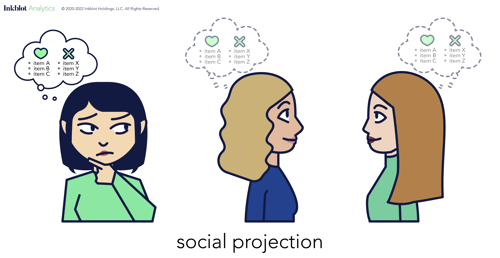
We are all part of ingroups and outgroups. Take your favorite sports team for instance. Everyone who is a fan of your team, including yourself, is an ingroup member. Everyone else—particularly those who do not identify with sports or your favorite team—is an outgroup member. Researchers Jordan Robbins and Joachim Kreuger conducted a meta-analysis that revealed how social projection works in groups. They concluded that, “Projection is stronger when people make judgments about ingroups than when they make judgments about outgroups.” (Robbins & Krueger, 2005, p. 32)
What is Ingroup Projection? An ingroup is a social group whose people psychologically identify themselves as members of. Ingroup projection occurs when an individual projects their own characteristics to other members of the ingroup.
What is Outgroup Projection? An outgroup is a social group whose people do not psychologically identify themselves as members of. Outgroup projection occurs when an individual projects characteristics they don’t have to members of an outgroup.
Both of these processes provide an important lens into social projection: from how it affects the functioning of our social world, to how people interact in groups and identify with them.
When we see the world through the eyes of projection, we can account for many normal phenomena: from rebellious children, to romantic relationships, to being poor estimators of future states. Projection is critical because it underlies so much of our perception and social cognition that affect these situations. It only makes sense that projection might also influence other situations, such as buyer behavior. Over the past two years, we’ve honed in on how to leverage tools that can tap into projection, and use projections to identify the psychological profile of individuals. If you’re interested in learning more, feel free to contact us today!
References:
Allport, F. H. (1924). Social Psychology. Cambridge, MA: Riverside Press.
Anne Hurry, Jack Novick & Kerry Kelly Novick. (1976). Freud's concept of projection, Journal of Child Psychotherapy, 4:2, 75-88.
Britton, R. (1998). Belief and imagination: Explorations in psychoanalysis. London: Routledge. 6.
Freud, Sigmund. (1894a). The neuro-psychoses of defence. SE, 3: 41-61.
Freud, S. (1894b). On the grounds for detaching a particular syndrome from neurasthenia under the description ‘anxiety neurosis’. In J. Strachey (Ed. & Trans.), The standard edition of the complete psychological works of Sigmund Freud. 85–115.
Freud, S. (1895). Draft H Paranoia from Extracts From The Fliess Papers. The Standard Edition of the Complete Psychological Works of Sigmund Freud, Volume I ( 1886-1899): Pre-Psycho-Analytic Publications and Unpublished Drafts, 206-212.
Freud S. (1900). In: The Interpretation of Dreams. James Strachey, translator. London: Hogarth Press. Standard Edition.
Freud, S. (1911). Psycho-analytic notes on an autobiographical account of a case of paranoia (dementia paranoides). InStandard edition of the complete works of Sigmund Freud, Vol. 12 (trans. by J. Strachey).
Freud, S. (1912-1913). Totem and Taboo. In J. Strachey et al. (Trans.), The Standard Edition of the Complete Psychological Works of Sigmund Freud, Volume XIII. London: Hogarth Press.
Freud S. (1915). In: The Unconscious. James Strachey, translator. London: Hogarth Press. Standard Edition.
Freud, S. (1919). General introductory lectures in psychoanalysis. In J. Strachey (ed. and trans.), The standard edition of the complete psychological works of Sigmund Freud. London: Hogarth Press.
Freud S. (1923). In: The Ego and the Id. James Strachey, translator. London: Hogarth Press. Standard Edition.
Freud, A. (1937). The Ego and the mechanisms of defense, London: Hogarth Press and Institute of Psycho-Analysis.
Grinberg, L. (1962). On a specific aspect of counter-transference due to the patient's projective identification. The International Journal of Psycho-Analysis, 43, 436.
Jung, C. G. (2012). General aspects of dream psychology. (REV - Revised). Princeton University Press. 50-56.
Klein, M. (1946). Notes on some schizoid mechanisms. International Journal of Psychoanalysis, 27(Pt 3-4), 99-110.
Klein, M. (1952). Notes on some schizoid mechanisms 1. In J. Riviere, & E. Jones (Eds.), (1st ed). Routledge. 200-320.
Lachkar, J. (1992). The narcissistic/borderline couple: A psychoanalytic perspective on marital treatment. Brunner/Mazel. 92.
Lindzey, G. (1961). Projective techniques and cross-cultural research. Appleton-Century-Crofts. 31.
Loewenstein, G., O'Donoghue, T., & Rabin, M. (2003). Projection Bias in Predicting Future Utility. The Quarterly Journal of Economics, 118(4). 1209-1248.
Loewenstein G. (2005). Hot-cold empathy gaps and medical decision making. Health psychology : official journal of the Division of Health Psychology, American Psychological Association, 24(4S). S49–S56.
Robbins, Jordan M.; Krueger, Joachim I. (2005). Social Projection to Ingroups and Outgroups: A Review and Meta-Analysis.
Sayers, J. (1991). Mothers of Psychoanalysis: Helen Deutsch, Karen Horney, Anna Freud, Melanie Klein. New York: W.W. Norton.
Discover how psychologists used general principles and conceptual similarities of projection to establish the sub-discipline of projective...
It’s no longer enough to know where people are, how old they are, and what type of job they hold; you need to know about what they like and how they...
A hallmark of projective techniques is the relatively ambiguous stimulus used to elicit uninhibited psychological data.
Be the first to know about new psychological insights that can help you optimize customer touchpoints and drive business growth.